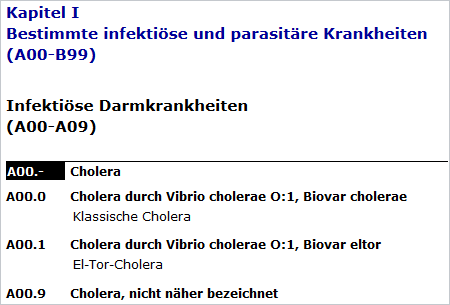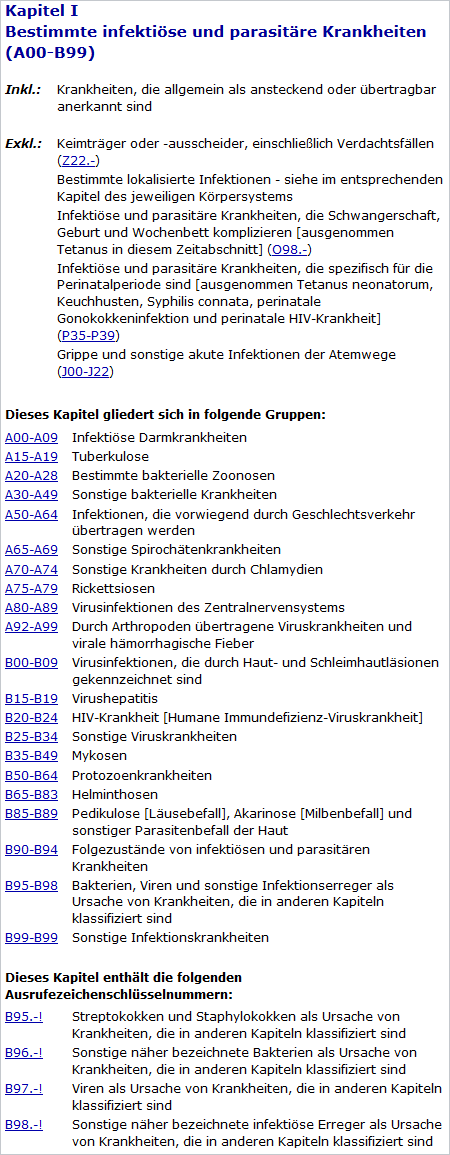VAS
Structure of ICD-10-WHO Tabular list
The Tabular List of inclusions and four-character subcategories (VAS), in brief: Tabular list, consists of 22 chapters (I to XXII), covering all diseases, with the organ-specific chapters III to XIV constituting the core. Diseases that cannot be allocated to a specific organ are pooled in the remaining chapters. Each chapter covers a code area designated by one, two (Ch. I, II, XIX) or four (Ch. XX) letters. The letters H and D are both used in two chapters each. The titles in English language you will find at the WHO website, see link below.
| Chapter | Code range | Class title |
|---|---|---|
| I | A00-B99 | Bestimmte infektiöse und parasitäre Krankheiten |
| II | C00-D48 | Neubildungen |
| III | D50-D89 | Krankheiten des Blutes und der blutbildenden Organe sowie bestimmte Störungen mit Beteiligung des Immunsystems |
| IV | E00-E90 | Endokrine, Ernährungs- und Stoffwechselkrankheiten |
| V | F00-F99 | Psychische und Verhaltensstörungen |
| VI | G00-G99 | Krankheiten des Nervensystems |
| VII | H00-H59 | Krankheiten des Auges und der Augenanhangsgebilde |
| VIII | H60-H95 | Krankheiten des Ohres und des Warzenfortsatzes |
| IX | I00-I99 | Krankheiten des Kreislaufsystems |
| X | J00-J99 | Krankheiten des Atmungssystems |
| XI | K00-K93 | Krankheiten des Verdauungssystems |
| XII | L00-L99 | Krankheiten der Haut und der Unterhaut |
| XIII | M00-M99 | Krankheiten des Muskel-Skelett-Systems und des Bindegewebes |
| XIV | N00-N99 | Krankheiten des Urogenitalsystems |
| XV | O00-O99 | Schwangerschaft, Geburt und Wochenbett |
| XVI | P00-P96 | Bestimmte Zustände, die ihren Ursprung in der Perinatalperiode haben |
| XVII | Q00-Q99 | Angeborene Fehlbildungen, Deformitäten und Chromosomenanomalien |
| XVIII | R00-R99 | Symptome und abnorme klinische und Laborbefunde, die anderenorts nicht klassifiziert sind |
| XIX | S00-T98 | Verletzungen, Vergiftungen und bestimmte andere Folgen äußerer Ursachen |
| XX | V01-Y98 | Äußere Ursachen von Morbidität und Mortalität |
| XXI | Z00-Z99 | Faktoren, die den Gesundheitszustand beeinflussen und zur Inanspruchnahme des Gesundheitswesens führen |
| XXII | U00-U99 | Schlüsselnummern für besondere Zwecke |
Chapters, blocks, categories
Chapters are divided into blocks, blocksdivided into categories. Chapters, blocks and categories are designated by a title, the class title. Class titles of categories are assigned a three-character alphanumeric code, shown on a black background in the print version. Chapters and blocks are designated by the range of codes within their scope.
For example, "Kapitel I Bestimmte infektiöse und parasitäre Krankheiten" (Chapter I Certain infectious and parasitic diseases) covers the code range A00-B99. The first block of "Infektiöse Darmkrankheiten" (Infectious intestinal diseases) comprises the code range A00-A09. The first category in this block is "A00 Cholera". Category A00 comprises three subcategories A00.0, A00.1 and A00.9; the fourth digit is always separated by a decimal point. Categories and subcategories are also referred to as rubrics:

Each chapter starts with a chapter preface containing a list of blocks included in the chapter as well as codes with asterisks. It can also include comments of concern to all blocks and categories within the chapter. Similarly, there may also be notes underneath block titles that are of concern to all categories within the block. Within the categories, there may be further notes providing more detailed information about the category. All notes from all different hierarchical levels have to be taken into account in the encoding process. The example below shows part of the preface to Chapter I; it contains an inclusion note ("Inkl.:") as well as several exclusion notes ("Exkl.:") which have to be taken into account for all categories A00-B99:

